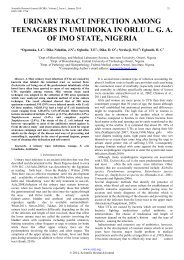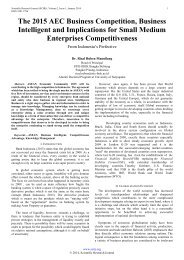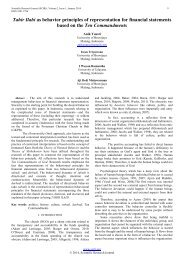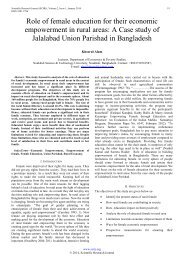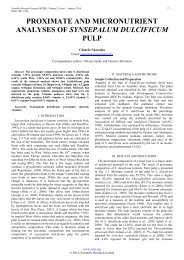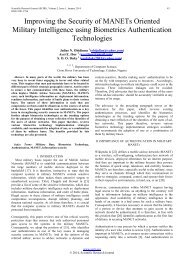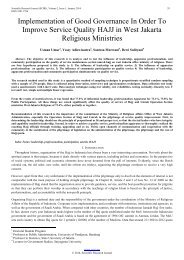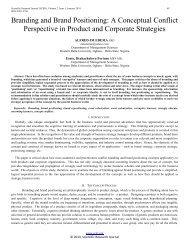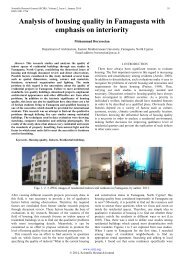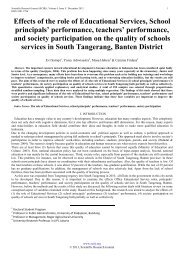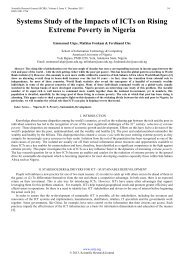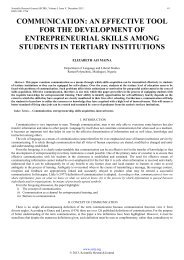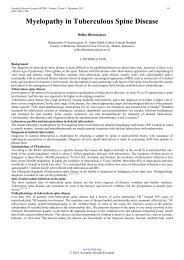RELATIVE EFFICACY OF ARTESUNATE OR AMODIAQUINE COMBINATION THERAPIES WITH SULPHODOXINE-PYRAMETAMINE IN CHILDREN WITH UNCOMPLICATED PLASMODIUM FALCIPARUM MALARIA IN BORNO STATE, NIGERIA
The study was carried out in the malaria holo-endemic settlements around Lake-Alau, Borno State, Nigeria between July to December, 2011. The aim was to compare the efficacy of Artesunate + Sulphadoxine-Pyrimethamine (AT+SP) and Amodiaquine + Sulphadoxine-Pyrimethamine (AQ+SP) in the treatment of uncomplicated Plasmodium falciparum malaria in children. A total of 313 children (6-59 months) were screened, using standard protocols for therapeutic efficacy studies on fever and parasitaemia and the results were evaluated using regression analysis. The results obtained indicated that 79.6% of the children were cleared of fever by AT+SP as against 78.3% by AQ+SP on the first 24 hours after treatment and achieved a daily rate of temperature clearance of 0.35 0C and 0.29 0C and daily reduction in febrile children of 22.04% and 21.99% with the respective drugs, within the early follow-up days (0 - 3). The remaining febrile were relieved by day 28 and temperatures normalized to 36.0 0C and 36.7 0C with the respective drugs. The results further revealed that both AT+SP and AQ+SP cleared the bulk of the parasites from 21,738 to 30/µl and 19,953 to 66/µl, respectively within the first three days of follow-up; with proportionate success rates of 85.1, 95.2, 99.0, 99.5, 99.9 and 99.9% and 78.7, 93.4, 98.4, 99.4, 99.6 and 99.7% on days 1, 2, 3, 7, 14 and 28, respectively. These translates to mean parasite clearance time of 28.45 hours and 29.92 hours, with concomitant mean fever clearance time of 29.36 hours and 31.65 hours in AT+SP and AQ+SP, respectively. Regression analysis further revealed that each µl of the blood parasites cleared gave a temperature relief of 0.2071 0C and 0.1714 0C with the respective drugs. These results clearly put the efficacy of AT+SP in fever clearance ahead of AQ+SP in both early and late follow-up days. Based on rapid parasite and fever clearance accompanied by faster PCV (%) recovery and higher frequency of adequate clinical and parasitological response (ACPR) of AT + SP (91.4%) it could be adjudged to be superior to AQ+ SP (84.5%). Therefore, the Artesunate based combination therapy (AT + SP) is recommended for control of P. falciparum malaria in children.
The study was carried out in the malaria holo-endemic settlements around Lake-Alau, Borno State, Nigeria between July to December, 2011. The aim was to compare the efficacy of Artesunate + Sulphadoxine-Pyrimethamine (AT+SP) and Amodiaquine + Sulphadoxine-Pyrimethamine (AQ+SP) in the treatment of uncomplicated Plasmodium falciparum malaria in children. A total of 313 children (6-59 months) were screened, using standard protocols for therapeutic efficacy studies on fever and parasitaemia and the results were evaluated using regression analysis. The results obtained indicated that 79.6% of the children were cleared of fever by AT+SP as against 78.3% by AQ+SP on the first 24 hours after treatment and achieved a daily rate of temperature clearance of 0.35 0C and 0.29 0C and daily reduction in febrile children of 22.04% and 21.99% with the respective drugs, within the early follow-up days (0 - 3). The remaining febrile were relieved by day 28 and temperatures normalized to 36.0 0C and 36.7 0C with the respective drugs. The results further revealed that both AT+SP and AQ+SP cleared the bulk of the parasites from 21,738 to 30/µl and 19,953 to 66/µl, respectively within the first three days of follow-up; with proportionate success rates of 85.1, 95.2, 99.0, 99.5, 99.9 and 99.9% and 78.7, 93.4, 98.4, 99.4, 99.6 and 99.7% on days 1, 2, 3, 7, 14 and 28, respectively. These translates to mean parasite clearance time of 28.45 hours and 29.92 hours, with concomitant mean fever clearance time of 29.36 hours and 31.65 hours in AT+SP and AQ+SP, respectively. Regression analysis further revealed that each µl of the blood parasites cleared gave a temperature relief of 0.2071 0C and 0.1714 0C with the respective drugs. These results clearly put the efficacy of AT+SP in fever clearance ahead of AQ+SP in both early and late follow-up days. Based on rapid parasite and fever clearance accompanied by faster PCV (%) recovery and higher frequency of adequate clinical and parasitological response (ACPR) of AT + SP (91.4%) it could be adjudged to be superior to AQ+ SP (84.5%). Therefore, the Artesunate based combination therapy (AT + SP) is recommended for control of P. falciparum malaria in children.
Create successful ePaper yourself
Turn your PDF publications into a flip-book with our unique Google optimized e-Paper software.
Scientific Research Journal (SCIRJ), Volume I, Issue II, September 2013 39<br />
ISSN 2201-2796<br />
[15] Gasasira, A. F.; Dorsey, G.; Nzarubara, B.; Staedke, S. G.; Nassali, A.; Rosenthal, P. J. and Kamya, M. R. (2003). Comparative efficacy of<br />
Aminoquinoline-Antifolate combinations for the treatment of uncomplicated falciparum malaria in Kampala, Uganda. American Journal<br />
of Tropical Medicine and Hygiene68: 127-132.<br />
[16] Gilles, H. (1993). Diagnostic methods in malaria. In: H. M Gilles and D. A. Warrell (Eds) Essential malariology, 3rd ed. P. Edwards<br />
Arnold London, United Kingdom.pp342.<br />
[17] Hamour, S.; Melaku, Y.; Keus, K.; Wambugu, J.; Atkin, S.; Montgomery, J.; Ford. N.; Hook, C. and Checchi, F. (2005). Malaria in the<br />
Nuba Mountains of Sudan: baseline genotypic resistance and efficacy of the Artesunate plus Sulfadoxine-Pyrimethamine and Artesunate<br />
plus Amodiaquine combinations. Transactions of Royal Society of Tropical Medicine and Hygiene. 99: 548-554.<br />
[18] Hyde, J. E. (1990), Thedihydrofolatereductase-thymidylatesynthetase gene in the drug resistance of malaria parasites. Pharmacology and<br />
Therapeutics. 48: 45-59.<br />
[19] Ménard, D.; Andrianina, N. N. H.; Ramiandrasoa, Z.; Randriamauantena, A.; Rasoarilaloa, N.; Jahevitra, M.; Ratsimbasoa, A.; Tuseo, L.<br />
and Ravelosan, A. (2007). Randomized clinical trial of Artemisinin versus non-Artemisinin combination therapy for uncomplicated<br />
falciparum malaria in Madagascar. Malaria Journal.6: 65-72.<br />
[20] Molta, N. B. (1995), Susceptibility of Plasmodium falciparum to malarial drugs in North-eastern Nigeria. Transactions of the Royal Society<br />
of Tropical Medicine and Hygiene. 89: 422-425.<br />
[21] Mukhtar, E. A.; Gadella, N. B.; El-Zaki, S. E. G.; Mukhtar, I.; Mansour, F. A.; Babiker, A. and El-Sayed, B. B. (2007). A comparative<br />
study on the efficacy of Artesunate plus Sulphadoxine-Pyrimethamine versus artemether/lumifantrine in Eastern Sudan. Malaria Journal.<br />
6: 90-96.<br />
[22] National malaria control Programme/Federal Ministry of Health (1996). Annual Report.<br />
[23] Nahum, A.; Erhart, A.; Gazard, D.; Agbowai, C.; Van-Overmier, V.; Harry, V.; Menten, J.; Akogbeto, M.; Coosemans, M.; Achille, M.<br />
and D’Allessandro, U. (2007). Adding Artesunate to Sulphadoxine-Pyrimethermine greatly improves the treatment efficacy in children<br />
with uncomplicated falciparum malaria on the cost of Benin, West Africa. Malaria Journal.6(10): 1475-1484.<br />
[24] Nosten, F.; McGreagy, R.; Looaresuwan, S. and White, N. (2003). Maternal Malaria: Time for action. Tropical Medicine and International<br />
Health.8(6): 485-487.<br />
[25] Price, R. N. F.; Nosten, C.; Luxemburger, F. O.; terKuile, L.; Paiphun, T.; Chongsuphajaisiddhi, T. and White. N. J. (1996). Effects of<br />
Artemisinin derivatives on malaria transmissibility. Lancet. 347: 1654-1658.<br />
[26] Rieckmann, K. H., Davis, D. R. and Hutton, D. C. (1989), Plasmodium vivax resistance to chloroquine? Lancet. 2: 1183-1184.<br />
[27] Sowunmi, A.; Tunde, B.; Grace, O. G.; Happi, C. T.; Adeniji, A. A. and Fehintola, F. A. (2007). Activities of Amodiaquine and<br />
Artesunate-Amodiaquine against asexual and sexual stage parasites in falciparum malaria in children. Antimicrobial Agent<br />
Chemotheraphy.10: 1128-1145.<br />
[28] Tagbor, H; Bruce, J; Browne, E; Randal, A; Greenwood, B. and Chandramohan, D.(2006). Efficacy, safety, and tolerability of<br />
Amodiaquine plus Sulphadoxine-Pyrimethamine used alone or in combination for malaria treatment in pregnancy: a randomised trial.<br />
Lancet. 368: 1349–1356.<br />
[29] Talisuna, A. O.; Staedke, S. G. and D'Alessandro, U. (2004). Pharmacovigilance of antimalarial treatment in Africa: is it possible? Malaria<br />
Journal.5(50): 2875-2885.<br />
[30] Umotong, A. B.; Ezedinachi, E. N.; Okerengwo, A, A.;Usanga, E. A.; Udo, J. J. and Williams, A. I. (1991). Correlation between in vivo<br />
and in vitro response of Choloroquine resistant Plasmodium falciparum in Calabar, South-Eastern Nigeria. ActaTropica. 49: 119-125.<br />
[31] Van den Broek, I.; Amsalu, R.; Balasegaram, M.; Hepple, P.; Alemu, E.; Hussein, E. B.; Al-Faith, M.; Montgomery, J. and Checchi, F.<br />
(2005). Efficacy of two Artemisinin combination therapies for uncomplicated falciparum malaria in children under 5 years, Malakal, Upper<br />
Nile, Sudan. Malaria Jornal. 4: 14-19.<br />
[32] Watkins, W. M. and Mosobo, M. (1993). Treatment of Plasmodium falciparum malaria with Pyrimethamine-Sulfadoxine: selective<br />
pressure for resistance is a function of long elimination half-life. Transactions of the Royal Society of Tropical Medicine and Hygiene. 87:<br />
75-78.<br />
[33] White, N. J. (2004), Antimalarial drug resistance. Journal Clinical Investigation. 113: 1084-1092.<br />
[34] World Health Organization (1991). Basic Malaria Microscopy. (part I and II ) (WHO-OMS), 72 pp.<br />
[35] World Health Organization (1996). Assessment of therapeutic efficacy for uncomplicated falciparum malaria in areas with intense<br />
transmission. Geneva: World Health Organization. Unpublished document, WHO/MAL/96.1077.PP-32<br />
[36] World Health Organization (2003). Assessment and Monitoring of Antimalarial Drug Efficacy for the Treatment of Uncomplicated<br />
Falciparum Malaria. Geneva, Switzerland: WHO; 2003. Technical document, WHO/ RBM/HTM/2003.50.<br />
[37] World Health Organization (2006). WHO Guidelines for the Treatment of Malaria. Geneva, Switzerland: Technical document,<br />
WHO/HTM/MAL/2006.1108.<br />
[38] Zongo, I.; Dorsey, G.; ouamba, N.; Dokomajilar, C.; Lankoande, M.; Ouedraogo, J. B. and Rosenthal, P. J. (2005). Amodiaquine,<br />
Sulfadoxine-Pyrimethamine, and combination therapy for uncomplicated falciparum malaria: a randomized controlled trial from Burkina<br />
Faso. American Journal of Tropical Medicine and Hygiene. 73: 826-832.<br />
[39] Zongo, I.; Dorsey, G.; Rouamba, N.; Tinto, H.; Dokomajilar, C.; Guiguemde, R. T.; Rosenthal, P. J. and Ouedraogo, J. B. (2007).<br />
Artemether-Lumefantrine versus Amodiaquine plus Sulfadoxine-Pyrimethamine for uncomplicated falciparum malaria in Burkina Faso: a<br />
randomised non-inferiority trial. Lancet. 369: 491-498.<br />
www.scirj.org<br />
© 2013, Scientific Research Journal





